Family Business Matters
Eight Practical Succession Ideas
Winter offers time to plan for progress in your family business. As you contemplate the coming months, here are eight ideas to bolster your management-succession and estate-planning efforts.
1. Update your balance sheet. Many families own land passed down through the generations and don't like to show the land at its fair market value, or at least are very conservative in their valuation. While you may never intend to sell the land, making progress on your estate plan requires an honest and realistic understanding of the value of your assets to help minimize the consequences of estate and income taxes.
2. Chart a future ownership path. Younger family members who return to the farm often do so without a clear understanding of how they will achieve ownership of the business and assets. Will it be a gift? A sale? When will it occur? Will they have to buy out off-farm siblings? Without answering these questions, people operate based on assumptions, which usually leads to conflict or disappointment down the road.
3. Hand off a management task. A frequent complaint by next-generation members is that the senior generation never fully lets go of business tasks. This year, plan for the transition of a discreet business function. It could be specific input purchases, equipment trade decisions, planting, harvest, crop insurance or Farm Service Agency enrollment, to name a few.
P[L1] D[0x0] M[300x250] OOP[F] ADUNIT[] T[]
4. Refresh your estate-planning documents. Years or decades often pass between reviews of your basic documents. Take a fresh look at your wills and trusts, trustees, beneficiary designations, advance medical directive and financial power of attorney. Make sure your basic estate-planning documents say what you want them to say.
5. Review retirement funding. Many farmers and ranchers have reinvested their profits into the business or land. Retirement, then, is financially tied to the continuation of the business, which makes a transition much harder. Meet with a financial planner to map out how you will receive retirement income in the future.
6. Assess the tax consequences of exiting. Related to retirement funding is the tax liability associated with getting out of farming. Because of deferred income, prepaid expenses and fully depreciated equipment, exiting farming or ranching can mean significant tax exposure. Develop a plan with your accountant three to five years ahead of when you actually intend to get out.
7. Introduce your family members to your landowners. If you rent much property from an absentee landowner, your business will eventually need to transition those relationships. You may not be able to influence the landowner's transition, but you can make sure the landowner knows your family members who will likely take over for you someday. That reduces risk in your business.
8. Clarify how your children will get out of business together. Passing land from one generation to the next often means that siblings or cousins will be business partners, either with undivided interests in land or as shareholders or members of a legal entity. Family members do not always make good business partners, so a helpful tool is a "buy-sell agreement," which spells out how partners can buy each other's interest if someone wants to sell. Talking with your attorney and establishing an agreement before anyone wants to sell is critical to its perceived fairness, and it helps reduce the potential for family conflict.
Succession and estate planning can feel overwhelming. The key is to keep putting one foot in front of the other. Taking any, or all, of the steps mentioned here can move your family business toward a successful transition.
**
-- Write Lance Woodbury at Family Business Matters, 2204 Lakeshore Dr., Suite 415, Birmingham, AL 35209, or email lance.woodbury@pinionglobal.com
[PF_0123]
(c) Copyright 2023 DTN, LLC. All rights reserved.




